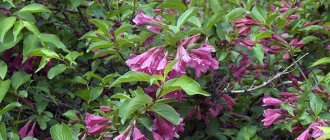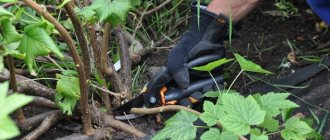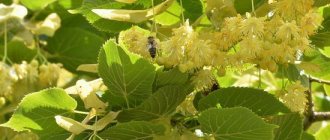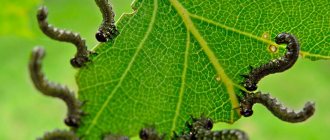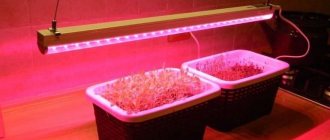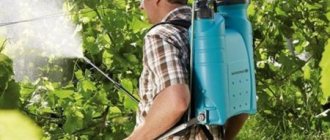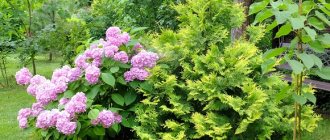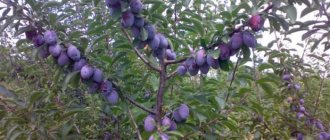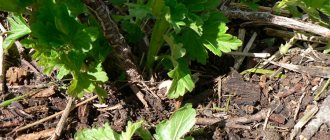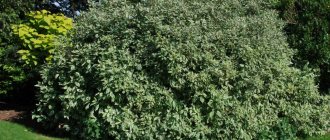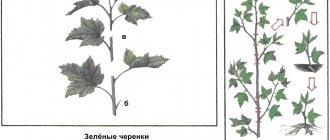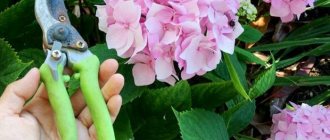I really like the lavender scent. Appearance, silvery branches, beautiful delicate lilac flowers - everything is pretty about this plant. Some time ago I planted quite a bit for testing, but over time the bushes grew and the question arose of what to do next. And a friend asked for several cuttings. It turns out that there are several ways to propagate this plant, but we must not forget about the rules of care. Today I want to tell you how to care for lavender and correctly, following agricultural practices, propagate it by cuttings.
a brief description of
Lavender is widely used all over the world as a medicinal plant with many healing properties. However, lavender extracts and essential oils are also widely used in cosmetology. It is grown industrially, in entire plantations. But it is becoming more and more popular among amateur gardeners.
Its wonderful aroma and medicinal properties help people, and its delicate inflorescences look great in any garden plot. You can successfully plant in rock gardens, alpine slides, in the first row in front of taller garden ornamental plants. Some people grow lavender in pots, since in regions with harsh climates it is not always possible to grow small bushes in open ground.
- The plant belongs to the Lamiaceae family, which includes more than 30 species. But in culture, mainly only 2 varieties are grown: broad-leaved (French) and narrow-leaved (English).
- This beautiful name comes from the Latin - “to wash”. It was for this purpose that fragrant herb was used in past centuries. But today it is also a source of valuable essential oils.
- This is a perennial shrub with a well-developed root system that goes deep into the soil several meters.
- The above-ground part consists of many strong shoots about 60 cm high. Over time, they become woody.
- The leaves are elongated, linear, located oppositely on the branch, and have a characteristic greenish-silver tint.
- Small flowers, depending on the type and variety, have a bluish color, different shades of lilac. They are collected in inflorescences similar to spikelets, 6-10 pieces each. The inflorescence is located on the upper part of the stem, which does not have leaves.
- The flowering period of the plant begins in the second half of the summer season. Lavender is considered an excellent honey plant.
- Lavender seeds have the advantage of remaining viable for many years.
Relatives of this wonderful culture are well-known garden plants: basil, sage, mint, rosemary, lemon balm and motherwort.
Types of lavender
Only a few types of this crop are used in gardening in the middle zone. They differ from each other not only in external characteristics, but also in the methods of cultivation.
English (narrow-leaved)
This species is most common in temperate regions. It has a certain resistance to unpredictable and difficult climates and tolerates winter frosts well.
English lavender is characterized by narrow leaves and elongated spike-shaped inflorescences with small lilac flowers. There is no need to dig up representatives of this species at the end of autumn.
French (broadleaf)
Lavender of this type is quite demanding, especially regarding the climate. Frosts of more than 15 degrees can destroy a delicate plant. Therefore, in most cases, in regions with cold and frosty winters, it is grown only in pots. It is possible to grow in open ground, but for the winter it needs to be replanted and brought indoors.
There is an external resemblance to English lavender, but the leaf blades are wider and the structure of the flower is slightly different. The inflorescences of this species are not so elongated.
Propagation of lavender by cuttings
If you have plantings of this plant on your site, then over time they grow quite strongly. Lavender can be propagated and planted in different ways. But due to the fragile structure of the root system, the most acceptable method is propagation using cuttings. When the bushes grow too much, then it is more advisable to choose a more difficult and risky method of dividing the bush. Let us consider in more detail how and when it is better to carry out the above procedures.
When to take cuttings?
This method is suitable when you just need to propagate a plant. It doesn't take much time or effort and doesn't put the rest of the plant at risk.
- You can take cuttings of both mature, lignified branches and very young, green ones.
- The procedure must be carried out in summer or spring so that the plant has time to take root and adapt before the onset of cold weather.
- You can take cuttings at the very beginning of spring. But in order to wait for the main mother bush to bloom well, it is advisable to take cuttings for planting after the flowering period, starting in mid-summer.
- Towards the end of the summer season, you can use cuttings if you live in the south, where winters are warm and there are very few or no frosts.
- In order for the first root shoots to appear on the cuttings and the root system to begin to form, you need to wait almost 1.5 months.
Step-by-step technology for propagation by lavender cuttings
- You can use green cuttings from young shoots. A prerequisite is that there should be at least several nodes in the lower part, and the length of the cuttings should be 10 - 12 cm. Such shoots are soft, take root faster and grow.
- If you decide to make cuttings from lignified twigs, then such a shoot should have at least 2-3 cm of green young part for planting. For such cuttings, a stimulator for root growth is required. Kornevin is usually used. Before planting in the ground, the cuttings are immersed in such a solution for a day and then planted.
- You can choose a suitable growth stimulator at any flower shop. The composition usually includes growth hormone, vitamin B1, this is not just a fertilizer.
- Pre-prepare special pots or containers for cuttings. The shoots are quite sensitive to both too dry soil and waterlogged soil. To maintain the water balance necessary for the development of the root system, purchase a special substrate: it should contain 1 part of organic fertilizer (compost) and 1 part of perlite (homemade); in the store, the required soil mixture will consist of sphagnum and perlite in equal quantities.
- Experienced gardeners recommend choosing pots made from natural materials, such as clay. At night, before planting, it can be kept in water.
- Then select a cutting, and with a sharp, disinfected knife, cut off a shoot about 13 cm long and with 2-3 nodes. You cannot cut it with scissors, so as not to crush the stem.
- Leave a few healthy leaves on the top and remove the rest. The leaves saturate the entire plant with energy. When pruning, try not to disturb the structure of the bark or damage it.
- After removing the cutting from the solution with a growth stimulator, stick it into the ground a few cm. It is important that the shoot can be held in an upright position. There is no need to compact the soil. After planting, water the soil thoroughly.
Care after landing
Many gardeners make a common mistake: they begin to intensively moisten the soil in the container with cuttings, which is not recommended. Water when the top layer of soil dries out.
Keep the cuttings in the shade, only gradually reduce the amount of watering and place the plants in an area with diffused light. By observing such a gentle regime, you will create the necessary conditions for faster rooting of cuttings.
If the room humidity is low and the shoot dries out, cover it with film. It will gain the necessary moisture from the root system.
After 3 - 6 weeks, the root system of the lavender cutting will already produce roots of the required length. You can transplant the young plant along with a lump of earth into a separate pot or into open ground.
Be sure to make a drainage layer in the dug hole. Then replant the cutting. Further care is the same as for other plants.
Possible problems
A white or pink coating may appear on the root collar of cuttings and adult plants. With its appearance, the plant begins to fade. This disease is called Fusarium wilt. For prevention, the soil is treated with special chemicals.
Yellow spots may appear on young shoots, which turn gray over time. The branches wither, dry out and curl. This is a stem blight infection. All damaged branches must be removed and the bushes treated with Bordeaux mixture.
To grow lavender bushes in your dacha or yard using cuttings or any other method, you need to be patient and knowledgeable. Then this amazing plant will delight its owners with abundant flowering and an unforgettable aroma.
—Tags
—Categories
- universal education (38)
- dacha (206)
- decor (244)
- for home (82)
- for yourself beloved (644)
- traditional health recipes (394)
- sports for health (107)
- DIY cosmetics (53)
- makeup (24)
- proper nutrition (55)
- Painting graphics painting (188)
- winds (3)
- folk traditions. Painting (30)
- Spot growth (43)
- Drawing lessons. Drawings. Images. (31)
- interior (56)
- cardboard furniture (3)
- indoor plants (53)
- computer (43)
- COOKING (3230)
- dishes in a slow cooker (35)
- Main courses (cereals, vegetables, mushrooms.) (444)
- main courses in pots (22)
- meat main courses (338)
- fish main courses (96)
- Baking (549)
- Baking pies, cupcakes (338)
- Baking cakes and pastries (335)
- Baking Easter cakes (26)
- Baking gingerbread (23)
- desserts (192)
- Canning (229)
- First courses (98)
- Salads (291)
- Sauces (43)
- cheeses (34)
- Fondue (7)
- snacks (312)
- tea, drinks, etc. (67)
- My works (12)
- My dog (8)
- music (22)
- Festive (132)
- Handicrafts (4992)
- nylon toy (88)
- costume jewelry - jewelry from everything (32)
- toy in folk traditions (15)
- embroidery BLACKWORK (13)
- kanzashi (8)
- cotton wool toy (5)
- bargello embroidery (4)
- paper - creativity (3)
- cardboard (3)
- carpets, weaving, tapestries (3)
- Topiary (3)
- natural materials: birch bark, burning, etc. (43)
- batik (37)
- bead embroidery (48)
- beads knitting (24)
- Bead weaving (248)
- Felting (282)
- Felt felt (64)
- cross stitch and more (737)
- knitting (319)
- knitting - clothing (137)
- knitting - tatting (20)
- Guilloche (3)
- Decoupage (32)
- jute filigree (56)
- doll toy (87)
- soft toy (233)
- Tin foil and wire (35)
- From plastic bottles (55)
- leather goods (35)
- Isothread (7)
- Books, magazines (85)
- Ribbons (200)
- Modeling (194)
- patchwork plastic patchwork (449)
- Macrame (33)
- Master classes (980)
- eggshell mosaic (4)
- Origami (8)
- papier-mâché (19)
- alterations (74)
- newspaper weaving (160)
- bobbin weaving (10)
- crafts (105)
- pillows (56)
- straw weaving (25)
- Cosmetic bags (219)
- soutache (20)
- embroidery lessons (11)
- Flowers made of nylon, fabric, paper (189)
- curtains (44)
- sewing: folk costume (11)
- sewing: fashion, trends, fashion history (37)
- sewing - processing of components and parts (69)
- sewing - clothes and accessories (modelling, design (415)
- Diary design lessons (19)
- movies (5)
- Photoshop and photo craftsmanship (43)
- This is interesting (187)
Adviсe
- You can propagate lavender by dividing the bush. But the plant does not tolerate this method very well, so it is recommended to use it last. When you need to save the bush itself or, conversely, sacrifice one bush and make many cuttings. This method can be used when the bush is at least 3 - 5 years old.
- Don't rush to divide the bush. Try pruning first. Starting from the second year, trim the bush by at least a third. In the first year, lavender is not pruned, as the root system is actively developing.
- If the middle of the bush begins to dry out, and flowering has decreased, then perhaps weather conditions have this effect. Take a few cuttings, replant them, and watch the bush a little.
When is the best time to propagate by dividing the bush?
How to propagate hydrangea by cuttings in spring
The shrub can be divided both in autumn and spring. The main thing is to prepare a copy for the procedure in advance. Each case has its own nuances and features of division and planting. The same applies to rooting layering.
Features of propagation by dividing the bush in spring
In spring, division can be done until the first signs of a peduncle appear. Additionally, you need to hill up the plant in the fall and carefully monitor the growth of branches. For planting, choose a time when no rain is expected, so that the specimen does not lock.
Planting process
Reproduction by dividing the bush in the summer
Transplantation from the mother specimen is also possible in the summer, but you will have to take very careful care: accurately monitor the watering regime, organize shade for the plants.
How to propagate by dividing a bush in the fall
Autumn is the most optimal season for propagation using this method. It is necessary to hill up the bush in the spring and divide at the right time. It is advisable to carry out the procedure no later than September.
